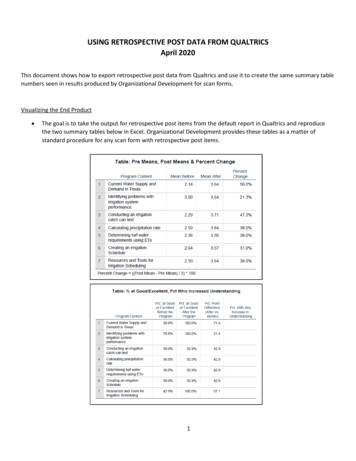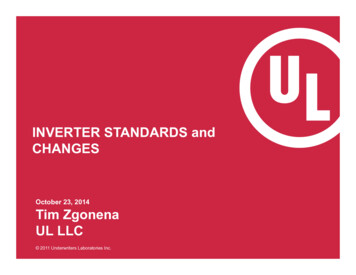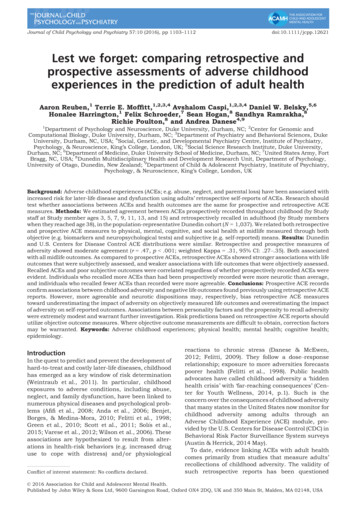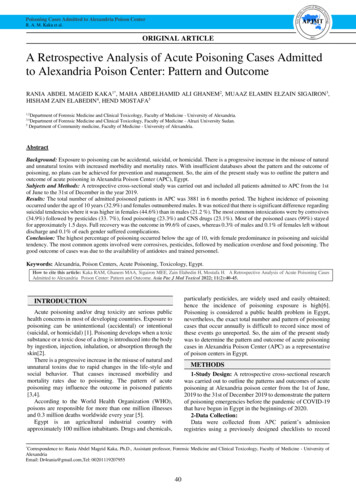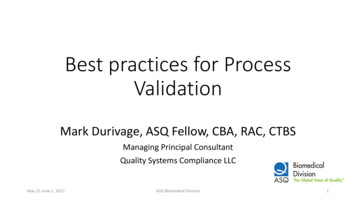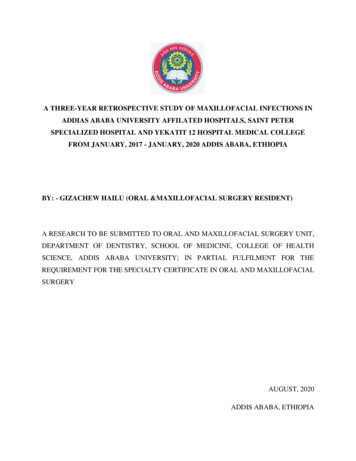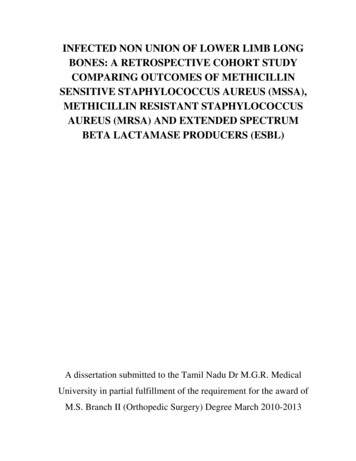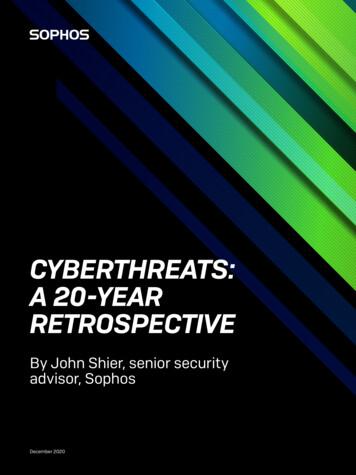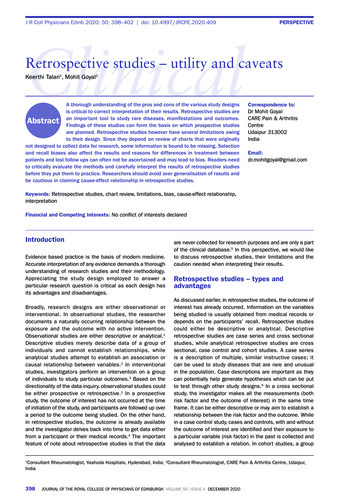
Transcription
J R Coll Physicians Edinb 2020; 50: 398–402 doi: tive studies – utility and caveatsKeerthi Talari1, Mohit Goyal2A thorough understanding of the pros and cons of the various study designsis critical to correct interpretation of their results. Retrospective studies areimportant tool to study rare diseases, manifestations and outcomes.Abstract anFindings of these studies can form the basis on which prospective studiesare planned. Retrospective studies however have several limitations owingto their design. Since they depend on review of charts that were originallynot designed to collect data for research, some information is bound to be missing. Selectionand recall biases also affect the results and reasons for differences in treatment betweenpatients and lost follow ups can often not be ascertained and may lead to bias. Readers needto critically evaluate the methods and carefully interpret the results of retrospective studiesbefore they put them to practice. Researchers should avoid over generalisation of results andbe cautious in claiming cause-effect relationship in retrospective studies.Correspondence to:Dr Mohit GoyalCARE Pain & ArthritisCentreUdaipur 313002IndiaEmail:dr.mohitgoyal@gmail.comKeywords: Retrospective studies, chart review, limitations, bias, cause-effect relationship,interpretationFinancial and Competing Interests: No conflict of interests declaredIntroductionEvidence based practice is the basis of modern medicine.Accurate interpretation of any evidence demands a thoroughunderstanding of research studies and their methodology.Appreciating the study design employed to answer aparticular research question is critical as each design hasits advantages and disadvantages.Broadly, research designs are either observational orinterventional. In observational studies, the researcherdocuments a naturally occurring relationship between theexposure and the outcome with no active intervention.Observational studies are either descriptive or analytical.1Descriptive studies merely describe data of a group ofindividuals and cannot establish relationships, whileanalytical studies attempt to establish an association orcausal relationship between variables.2 In interventionalstudies, investigators perform an intervention on a groupof individuals to study particular outcomes.3 Based on thedirectionality of the data inquiry, observational studies couldbe either prospective or retrospective. 1 In a prospectivestudy, the outcome of interest has not occurred at the timeof initiation of the study, and participants are followed up overa period to the outcome being studied. On the other hand,in retrospective studies, the outcome is already availableand the investigator delves back into time to get data eitherfrom a participant or their medical records.4 The importantfeature of note about retrospective studies is that the dataare never collected for research purposes and are only a partof the clinical database.5 In this perspective, we would liketo discuss retrospective studies, their limitations and thecaution needed when interpreting their results.Retrospective studies – types andadvantagesAs discussed earlier, in retrospective studies, the outcome ofinterest has already occurred. Information on the variablesbeing studied is usually obtained from medical records ordepends on the participants’ recall. Retrospective studiescould either be descriptive or analytical. Descriptiveretrospective studies are case series and cross sectionalstudies, while analytical retrospective studies are crosssectional, case control and cohort studies. A case seriesis a description of multiple, similar instructive cases; itcan be used to study diseases that are rare and unusualin the population. Case descriptions are important as theycan potentially help generate hypotheses which can be putto test through other study designs.6 In a cross sectionalstudy, the investigator makes all the measurements (bothrisk factor and the outcome of interest) in the same timeframe. It can be either descriptive or may aim to establish arelationship between the risk factor and the outcome. Whilein a case control study, cases and controls, with and withoutthe outcome of interest are identified and their exposure toa particular variable (risk factor) in the past is collected andanalysed to establish a relation. In cohort studies, a groupConsultant Rheumatologist, Yashoda Hospitals, Hyderabad, India; 2Consultant Rheumatologist, CARE Pain & Arthritis Centre, Udaipur,India1398JOURNAL OF THE ROYAL COLLEGE OF PHYSICIANS OF EDINBURGH VOLUME 50 ISSUE 4 DECEMBER 2020
Retrospective studiesof individuals with exposure to a risk factor are prospectivelyfollowed to determine the occurrence of the outcome.7 Whilethese are mostly prospective studies, a cohort study can beretrospective too. This is primarily done to reduce cost andduration of follow up. An association between the variableand the outcome may be derived from cohort studies.Retrospective studies have a place in research and many ofthem have helped shape the clinical practices. An example ofthe utility of retrospective studies is the landmark paper thatdescribed the association between smoking and lung cancer.8The study revealed that smokers were at a significantly higherrisk of developing carcinoma of the lung compared to nonsmokers. Such a hypothesis could have never been putthrough the test of a randomised trial.Another landmark retrospective chart review in the 1990sfound that spinal anaesthesia was faster, easier toadminister and more comfortable and safe for the patientfor caesarean section, as compared to epidural anaesthesia.9Until then, epidural was the preferred mode of anaesthesiaadministration in caesarean section, but we have sinceseen a paradigm shift towards spinal anaesthesia; by2009, 85% of obstetricians in the United States were usingspinal anaesthesia for caesarean section and another 11%were combining it with epidural.10 Some scenarios whereretrospective studies can be of use are given in Box 1.Limitations of retrospective studiesWhile retrospective studies save on funds and time and areuseful in studying rare diseases and rare outcomes, theyare marred by their fallacies. Retrospective studies dependon data that were entered into a clinical database and notcollected for research. Since the data was not collected ina predesigned proforma as per the specific requirements ofthe study, in most of the cases some data would inevitablybe missing. Also, certain variables that have the potentialto impact the outcome may not have been recorded at all.11The United States Renal Data System (USRDS) is a robustdatabase with details of patients with end stage renal disease(ERDS) across the country. They make the data availablefreely to the researchers for analysis.12 Retrospectiveanalyses of the same data by different researchers haveshown conflicting conclusions regarding reuse of dialysersand patient mortality. While some studies found increasedmortality related to reuse, another found that there wereother confounders that could have influenced the mortalityin the reuse group.13-15 Also, different analyses of the USRDSdata by various researchers have shown similar, better andeven worse outcomes with haemodialysis when compared toperitoneal dialysis in patients with ERDS.16,17,18 Older chartsare likely to have missing information and unavailabilityof information on confounders leads to bias. Sometimeswhere the disease is very severe at presentation, othersupposedly minor abnormalities may not be recorded andremain unaccounted for during retrospective analysis.This is an example of how unknown and unnoticed biasesBox 1 Conditions where retrospective studies are useful Rare diseases where the population needed tostudy is too large to identify the few who develop theoutcome of interest Rare exposures where the number of people exposedmay be too low and hence may take too long forenough numbers to develop the outcome of interest Where the duration between the exposure and theoutcome is too long, thus reducing the feasibility ofa prospective study Where there are funding constraints towards planninga prospective studycreep into retrospective studies and all of these cannot beaccounted for.Many times, the investigator fills in missing data by lookingat records at different time points (previous or next visit)which is also fallacious. It is also common practice to askthe patients to recall certain details to collect data forretrospective studies. This introduces a systematic errorcalled ‘recall bias’.19 Patients may not be able to recall ordescribe the details accurately, resultantly certain detailsmay be omitted or altered. The accuracy and the volumeof memory of a certain event are usually dependent on theimpact of that event.20 Thus, there is always the chancethat an event of lesser magnitude and the finer details willnot be accurately recalled. Human memory is imperfectand study results based on them cannot be relied upon.In many manuscripts, while the authors may not explicitlystate that certain information was retrieved through recall,it may be evident to the reader on careful reading. A noteshould, however, be made here that it is incumbent on theauthors’ part to declare that certain information was retrievedthrough recall by participants and it should also be listed asa limitation of the study.In most of the retrospective studies, it is assumed thatexcept for the variable under study which differs betweenthe cases and the controls, they are otherwise similar inall other respects. Researchers would argue that this iswhat confounding is all about, and adequate adjustment(matching and regression analysis) for such confoundingfactors was made. However, besides the recognised ones,there are always some unknown confounding factors thatremain unrecognised in retrospective studies.21 It is oftendifficult to identify appropriate study and control groups inretrospective studies. Since in these studies, researchershave no control over the exposure of cases versus controls,these unrecognised confounders may influence the results(Figure 1). This way a false association may be derivedbetween the variable of interest and the outcome evenwhen no true association exists. On the other hand, in aprospective study, certain unknown risk factors are identifiedand new variables that can influence the outcome may alsobe recognised. In retrospective studies, it may not alwaysbe possible to ascertain the reason for the lost follow ups.DECEMBER 2020 VOLUME 50 ISSUE 4 JOURNAL OF THE ROYAL COLLEGE OF PHYSICIANS OF EDINBURGH399
K Talari, M GoyalFigure 1 All confounderscannot be accounted for inretrospective studiesNon responders and those developing adverse effects orcomplications have a higher chance of being lost to followup, leading to bias. The various sources of error or bias inretrospective studies and measures to minimise them arelisted in Table 1.For example, an imaginary study looked at the recordsof all 50,000 patients with migraine that attended theoutpatient services of an institution in the last five years.All of these patients had undergone history taking andclinical examination. For a mean follow up duration of sixmonths, it was found that women had a significantly highernonsteroidal anti-inflammatory drug (NSAID) requirement permonth (five pills of NSAID at optimum dose in women versusthree in men, p 0.01). When other factors were adjustedfor, women still had a higher NSAID requirement. It wasconcluded that women with migraine had a lower thresholdfor NSAID use. Since all the patients were included and thedata were retrieved from records, selection and recall biaswere eliminated. But since at the time of their creation, theTable 1 Confounders and sources of error or bias in retrospective studies and how to minimise or account for themSource of biasHow it creeps inHow to minimiseBaselinecharacteristicsDifferences in baseline characteristics of the groups, that havethe potential to impact the outcomeChoose appropriate comparatorgroupSelection ofsubjectsThe study subjects may not be representative of the populationand reasons for non-selection may not be ascertainableStringent and validated (whereapplicable) selection criteriaChart selectionsData was not collected for research, resultantly some chartsare excluded due to missing of certain crucial informationDocument, mention in manuscriptand list the same as a limitationMissing data inchartsSince the data was not collected for research, even theincluded charts are bound to have some missing informationDocument, mention in manuscriptand list the same as a limitationReliance on recallAccuracy of missing data added by asking patients to recallmay be limited by inability to describe or inaccurate memoryIf recall is a major part,subjects must have comparableeducational statusAssumptionsInvestigators may try to complete missing data by assumingand approximating from data available at different time pointsAuthors must avoid suchpracticesLack ofhomogeneityDifferent people are involved at different times in patient careand data entry, especially when studies look at charts overmany yearsPlan studies such that theseerrors are minimisedPrescription biasPrescriptions may have varied according to patients’ riskprofiles and the exact reasons may not have been recordedMaximum details must beretrieved from records andaccounted forLoss of follow upReasons for lost follow-ups often cannot be ascertained inretrospective studies and can potentially bias the resultsManuscript should mention theseexclusions as limitationsGeneralisation ofresults by authorsDue to selection bias, results of retrospective studies are often List the limitations and do notnot generalisable to the whole populationover-generaliseClaiming causeeffectRetrospective studies generally only establish association andnot cause-effect between risk factor and outcome400Such claims must be avoidedJOURNAL OF THE ROYAL COLLEGE OF PHYSICIANS OF EDINBURGH VOLUME 50 ISSUE 4 DECEMBER 2020
Retrospective studiesrecords were not aimed at studying the association betweengender and NSAID requirement, other variables that canaffect the use of NSAIDs may not have been recorded.NSAID requirement and prophylactic treatment at baseline,frequency of episodes of headache and severity are factorsthat can confound the results of such a retrospective study.Migraine has been found to be more prevalent in women,and it is possible that they have more frequent and severeepisodes. Thus, it may not be a prudent conclusion to make.In prospective studies, as we move forward, multipleoutcomes can be assessed and analysed at different timeframes.21 The results obtained by a retrospective study arelimited; multiple outcomes cannot be studied at a time. Thisis because we identify the outcome first and the risk variableis looked at in the past. Concerning the recent retrospectiveanalysis of the use of hydroxychloroquine for COVID-19 whichwas later retracted (for different reasons), certain findingswere reported which demanded extreme caution on thepart of the reader.22 The registry in this study compriseddata of hospitalised patients from different countries, whichmight have had different guidelines for hospitalisation andvarying protocols for the administration of antimalarialsand macrolides in patients with COVID-19. For example, thenational guidelines in India at different times have advocatedthe use of these agents only in patients with severe diseaseand requiring intensive care, or for prophylaxis in health careworkers.23 There were significant differences in comorbiditiesbetween the survivors and non-survivors. Some of thesecomorbidities had been previously reported to be associatedwith a severe disease course in COVID-19 patients.24 Despitehaving a higher burden of cardiac comorbidities, significantlyfewer non survivors were on ACE inhibitors and statins. Also,it should have been acknowledged that cardiac complicationsunrelated to medications had already been documented inpatients with COVID-19, and were more likely to occur in thosewith severe disease.25, 26 Then, there are hitherto unexplainedfactors which have led to widely varied mortality from COVID-19in different countries. Authors used exploratory multivariateanalysis, which has its limitations and may not be the best toolto establish a cause-effect relationship. While retrospectivestudies with sound methods and data collection may providean association between the variable and the outcome, theyare generally not suited to determine causation.27ConclusionWhile they are valuable tools to study diseases, exposuresand outcomes that are rare, retrospective studies are rife withinherent limitations. The reader must understand and accountfor such limitations while analysing the results and beforeapplying them in the clinic. Retrospective studies are theright first step to formulate a hypothesis that may otherwiseneed exorbitant funding on a prospective design. When adisease is common enough, the results of a retrospectivestudy need to be confirmed in a prospective study, so thatunknown factors that could have influenced the study resultsare identified and accounted for. A true causal relationshipcan only be established by properly conducted prospectivestudies where there is an option of taking care of biases ofdifferent kinds.References1Ranganathan P, Aggarwal R. Study designs: Part 1 – Anoverview and classification. Perspect Clin Res. 2018; 9:184–6.2 Grimes DA, Schulz KF. Descriptive studies: what they can andcannot do. Lancet. 2002; 359: 145–9.3 Thiese MS. Observational and interventional study designtypes; an overview. Biochem Med (Zagreb). 2014; 24:199–210.4 Manja V, Lakshminrusimha S. Epidemiology and ClinicalResearch Design, Part 1: Study Types. Neoreviews. 2014; 15:e558–e69.5 Goje SK. Longitudinal vs retrospective studies. Am J OrthodDentofacial Orthop. 2017; 151: 10–1.6 Ortega-Loubon C, Culquichicon C, Correa R. The Importance ofWriting and Publishing Case Reports During Medical Training.Cureus. 2017; 9: e1964.7 Mann CJ. Observational research methods. Research designII: cohort, cross sectional, and case-control studies. EmergMed J. 2003; 20: 54–60.8 Doll R, Hill AB. Smoking and carcinoma of the lung; preliminaryreport. Br Med J. 1950; 2: 739–48.9 Riley ET, Cohen SE, Macario A, et al. Spinal versus epiduralanesthesia for cesarean section: a comparison of timeefficiency, costs, charges, and complications. Anesth Analg.1995; 80: 709–12.10 Aiono-Le Tagaloa L, Butwick AJ, Carvalho B. A survey ofperioperative and postoperative anesthetic practices forcesarean delivery. Anesthesiol Res Pract. 2009; 2009:510642.11 Altman DG, Bland JM. Missing data. BMJ. 2007; 334: 424.12 Ward RA, Brier ME. Retrospective analyses of large medicaldatabases: what do they tell us? J Am Soc Nephrol. 1999; 10:429–32.13 Held PJ, Wolfe RA, Gaylin DS, et al. Analysis of the associationof dialyzer reuse practices and patient outcomes. Am J KidneyDis. 1994; 23: 692–708.14 Feldman HI, Kinosian M, Bilker WB,et al. Effect of dialyzerreuse on survival of patients treated with hemodialysis. JAMA.1996; 276: 620–5.15 Collins AJ, Ma JZ, Constantini EG, et al. Dialysis unit andpatient characteristics associated with reuse practices andmortality: 1989-1993. J Am Soc Nephrol. 1998; 9: 2108–17.16 Vonesh EF, Moran J. Mortality in end-stage renal disease: areassessment of differences between patients treated withhemodialysis and peritoneal dialysis. J Am Soc Nephrol. 1999;10: 354–65.17 Fenton SS, Schaubel DE, Desmeules M, et al. Hemodialysisversus peritoneal dialysis: a comparison of adjusted mortalityrates. Am J Kidney Dis. 1997; 30: 334–42.18 Bloembergen WE, Port FK, Mauger EA, et al. A comparisonof mortality between patients treated with hemodialysis andperitoneal dialysis. J Am Soc Nephrol. 1995; 6: 177–83.19 Coughlin SS. Recall bias in epidemiologic studies. J ClinEpidemiol. 1990; 43: 87–91.20 Smith MC, Bibi U, Sheard DE. Evidence for the differentialimpact of time and emotion on personal and event memoriesfor September 11, 2001. Applied Cognitive Psychology. 2004;17: 1047–55.DECEMBER 2020 VOLUME 50 ISSUE 4 JOURNAL OF THE ROYAL COLLEGE OF PHYSICIANS OF EDINBURGH401
K Talari, M Goyal21 Euser AM, Zoccali C, Jager KJ, et al. Cohort studies:prospective versus retrospective. Nephron Clin Pract. 2009;113: c214–7.22 Mehra MR, Desai SS, Ruschitzka F, et al. RETRACTED:Hydroxychloroquine or chloroquine with or without a macrolidefor treatment of COVID-19: a multinational registry analysis.Lancet. 2020.23 Government of India. Revised Guidelines on ClinicalManagement of COVID – 19. Available from: alManagementGuidelineforCOVID1931032020.pdf40224 Guan WJ, Ni ZY, Hu Y, et al. Clinical Characteristics ofCoronavirus Disease 2019 in China. N Engl J Med. 2020; 382:1708–20.25 Huang C, Wang Y, Li X, et al. Clinical features of patientsinfected with 2019 novel coronavirus in Wuhan, China. Lancet.2020; 395: 497–506.26 Shi S, Qin M, Shen B, et al. Association of Cardiac Injury WithMortality in Hospitalized Patients With COVID-19 in Wuhan,China. JAMA Cardiol. 2020; 5: 802–10.27 Tofthagen C. Threats to validity in retrospective studies. J AdvPract Oncol. 2012; 3: 181–3.JOURNAL OF THE ROYAL COLLEGE OF PHYSICIANS OF EDINBURGH VOLUME 50 ISSUE 4 DECEMBER 2020
retrospective studies are case series and cross sectional studies, while analytical retrospective studies are cross sectional, case control and cohort studies. A case series is a description of multiple, similar instructive cases; it can be used to study diseases that are rare and unusual in the population. Case descriptions are important as they
